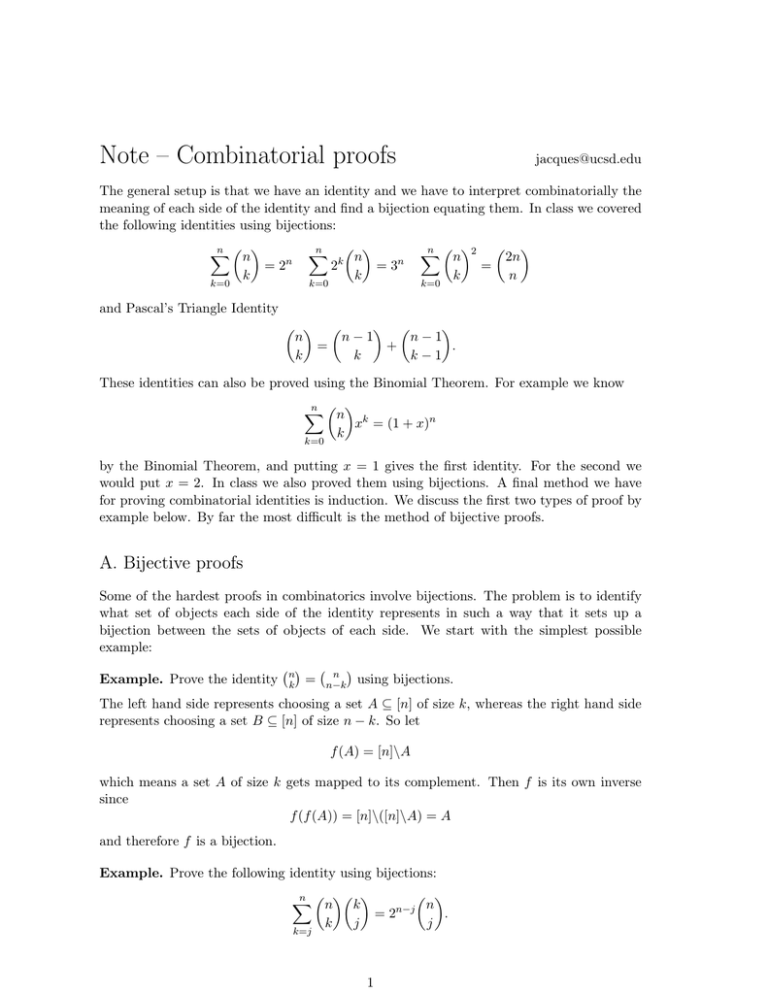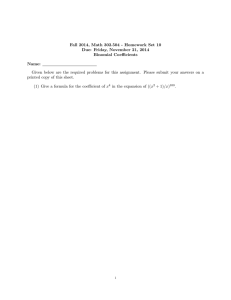Note – Combinatorial proofs
advertisement

Note – Combinatorial proofs
jacques@ucsd.edu
The general setup is that we have an identity and we have to interpret combinatorially the
meaning of each side of the identity and find a bijection equating them. In class we covered
the following identities using bijections:
n µ ¶
X
n
k=0
k
n
X
n
=2
k=0
µ ¶
n
2
= 3n
k
k
n µ ¶2
X
n
k=0
k
µ ¶
2n
=
n
and Pascal’s Triangle Identity
µ ¶ µ
¶ µ
¶
n
n−1
n−1
=
+
.
k
k
k−1
These identities can also be proved using the Binomial Theorem. For example we know
n µ ¶
X
n k
x = (1 + x)n
k
k=0
by the Binomial Theorem, and putting x = 1 gives the first identity. For the second we
would put x = 2. In class we also proved them using bijections. A final method we have
for proving combinatorial identities is induction. We discuss the first two types of proof by
example below. By far the most difficult is the method of bijective proofs.
A. Bijective proofs
Some of the hardest proofs in combinatorics involve bijections. The problem is to identify
what set of objects each side of the identity represents in such a way that it sets up a
bijection between the sets of objects of each side. We start with the simplest possible
example:
Example. Prove the identity
¡n¢
k
=
¡
n
n−k
¢
using bijections.
The left hand side represents choosing a set A ⊆ [n] of size k, whereas the right hand side
represents choosing a set B ⊆ [n] of size n − k. So let
f (A) = [n]\A
which means a set A of size k gets mapped to its complement. Then f is its own inverse
since
f (f (A)) = [n]\([n]\A) = A
and therefore f is a bijection.
Example. Prove the following identity using bijections:
µ ¶
n µ ¶µ ¶
X
n k
n
= 2n−j
.
k
j
j
k=j
1
The
a pair (A, B) where A ⊆ [n] has size j (that
¡n¢right hand side corresponds to choosing
n−j
is j choices) and B ⊆ [n]\A (that is 2
choices). On the left we pick a pair (C, D)
where C ⊆ [n] has size at least j and D ⊆ C has size j – this follows from the summation
principle. Therefore we define function
f (A, B) = (A ∪ B, A)
which is a bijection since g(C, D) = (D, C\D) is the inverse of f – to see this
f (g(C, D)) = f (D, C\D) = ((C\D) ∪ D, D) = (C, D)
so g is the inverse of f . This means f is a bijection, and the identity is proved.
Example. Prove the following identity using bijections:
µ ¶
n
X
n
= n2n−1 .
k
k
k=0
The right hand side corresponds to choosing a pair (i, A) where i ∈ [n] (that is n choices)
and A ⊆ [n]\{i} (that is¡ 2¢n−1 choices). The left side corresponds to choosing a pair (B, j)
where B ⊆ [n] (that is nk choices if |B| = k) and j ∈ B (that is k choices if |B| = k), by
the summation principle. Define
f (B, j) = (j, B\{j}).
Then f is a bijection since the inverse of f is
g(i, A) = (A ∪ {i}, i)
as can be checked by showing f (g(i, A)) = (i, A). This proves the identity.
Example. Prove the following identity using bijections:
n µ ¶
X
j
j=k
k
µ
¶
n+1
=
.
k+1
The right side represents choosing a set A ⊆ [n + 1] of ¡size
¢ k + 1. On the left side, we are
j
choosing a pair (j, B) where B ⊆ [j] has size k (that is k choices). Define
f (j, B) = B ∪ {j + 1}.
Note that f (j, B) is a set of size k + 1 in [n + 1]. Furthermore the inverse of f is
g(A) = (max A − 1, A\ max A).
To see this,
f (g(A)) = f (max A − 1, A\ max A) = A\ max A ∪ {max A − 1 + 1} = A
and so f is a bijection.
2
In the last example, why did we map f (j, B) to B ∪ {j + 1} instead of B ∪ {j}? The reason
is that B ⊆ [j] means j ∈ B is possible, in which case B ∪ {j} = B. So then we would
have f (j, B) = f (j, B\{j}) always, and f would not be a bijection. Another reason is that
on the right side, we have a set of size k + 1 inside [n + 1], and adding j + 1 to B ensures
|f (B, j)| = k + 1 and f (B, j) ⊆ [n + 1].
B. Formal power series proofs
The general idea given a combinatorial identity is to multiply each side by xk and then sum
over k so that on each side we can use the Binomial Theorem, or to recognize each side as
the Binomial Theorem with a specific value substituted for x.
Example. Prove the following identity using the Binomial Theorem:
µ ¶
n
X
n
k
= n2n−1 .
k
k=0
Each side looks like a derivative of the Binomial Theorem: indeed
µ ¶
n
n µ ¶
X
n k−1
d X n k
d
k
x
=
x =
(1 + x)n = n(1 + x)n−1
k
k
dx
dx
k=1
k=0
and now we put x = 1 in this equation. If we did not spot this, we would multiply each
side by xn and then sum over n: on the right hand side we have
∞
X
n2n−1 xn = x
n=0
∞
X
∞
n(2x)n−1 = x
n=1
d X
2x
(2x)n =
dx
(1 − 2x)2
n=0
using geometric series. On the left side we have
µ ¶
∞ µ ¶
∞
∞ X
n
X
n n X X n n
x .
k
x =
k
k
k
n=0 k=0
If we recall
¡n¢
k
n=k
= n(n − 1) · · · (n − k + 1)/k! then this is
∞
∞
X
kxk X
k=0
k=0
k!
n(n − 1)(n − 2) · · · (n − k + 1)xn−k =
n=k
∞
∞
X
kxk dk X n
x
k! dxk
k=0
n=0
where we are taking the kth derivative of the inner sum. Now the inner sum is 1/(1 − x)
by geometric series and
dk 1
k!
=
k
dx 1 − x
(1 − x)k+1
so the sum is
∞
X
kxk
k=0
∞
X
k!
x
·
=
kz k−1
k! (1 − x)k+1
(1 − x)2
k=1
where z = x/(1 − x). Since
∞
X
k=1
kz k−1 =
d 1
1
=
dz 1 − z
(1 − z)2
3
we get
∞
X
x
x
1
x
kz k−1 =
·
=
(1 − x)2
(1 − x)2 (1 − x/(1 − x))2
(1 − 2x)2
k=1
as required. While this was a long way of doing it, it illustrates the general method of
multiplying each side by a power of x and summing to prove an identity.
Example. Prove the following identity using the Binomial Theorem:
µ
¶
n µ ¶
X
j
n+1
=
.
k
k+1
j=k
Multiply the right side by xk+1 and sum over k to get
¶
¶
∞ µ
∞ µ
X
X
n + 1 k+1
n+1 k
x
=
x
k+1
k
k=0
k=1
¶
∞ µ
X
n+1 k
x −1
=
k
k=0
= (1 + x)n+1 − 1
by the Binomial Theorem. Now the right hand side is
j µ ¶
n X
n µ ¶
∞ X
X
X
j k+1
j k+1
x
x
=
k
k
j=0 k=0
k=0 j=k
=
n
X
x(1 + x)j
j=0
(1 + x)n+1 − 1
x
= (1 + x)n+1 − 1.
= x
The second line comes from the Binomial Theorem applied to the inner sum from the first
line, and the third line comes from adding up a finite geometric series i.e.
n
X
j=0
zj =
z n+1 − 1
z−1
with z = 1 + x. So we have verified using the Binomial Theorem that both sides of the
identity are equal, as required.
The key features of the last example were exchanging the order of summation, using the
Binomial Theorem, and then using the geometric series formula. The first two of these
features are again important in the following example.
Example. Prove the following identity using the Binomial Theorem:
µ ¶
n µ ¶µ ¶
X
n k
n−j n
=2
.
k
j
j
k=j
4
Multiply each side by xj and sum over j. The right side is
∞
X
j=0
n−j
2
µ ¶
∞ µ ¶
X
n j
n
n
x =2
(x/2)j = 2n (1 + x/2)n = (2 + x)n .
j
j
j=0
The left side is
∞ X
n µ ¶µ ¶
X
n k j
x
k
j
j=0 k=j
n X
k µ ¶µ ¶
X
n k j
=
x
k
j
k=0 j=0
n µ ¶X
k µ ¶
X
n
k j
=
x
k
j
j=0
k=0
n µ ¶
X
n
=
(1 + x)k
k
k=0
= (1 + 1 + x)n = (2 + x)n
as required. We used the Binomial Theorem from lines 3–5.
5





